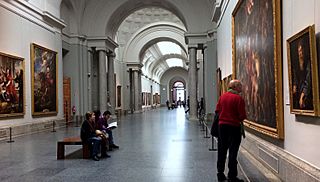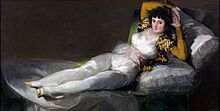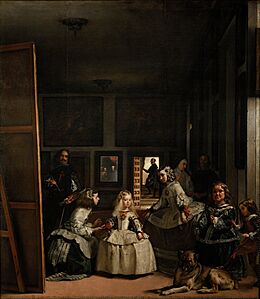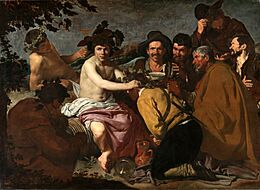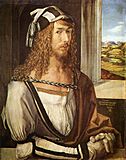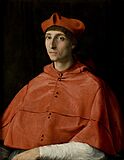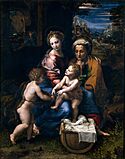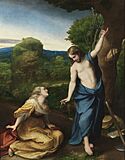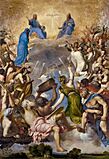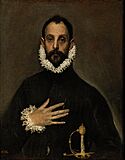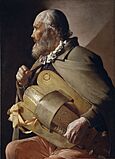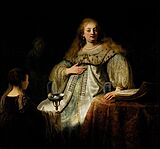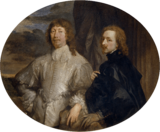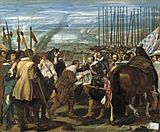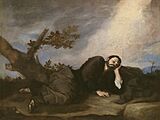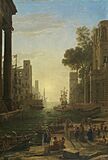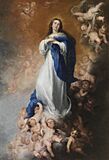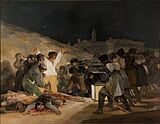Museo del Prado facts for kids
 |
|

Exterior of the Prado Museum
|
|
| Established | 1819 |
|---|---|
| Location | Paseo del Prado, Madrid, Spain |
| Type | Art museum, historic site |
| Visitors | 852,161 (2020) Ranked 13th globally (2023) |
| Public transit access | |
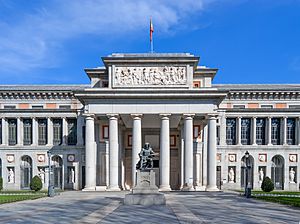
Museo del Prado (front façade)
|
|
| Architect | Juan de Villanueva |
| Official name: Museo Nacional del Prado | |
| Type | Non-movable |
| Criteria | Monument |
| Designated | 1962 |
| Reference no. | RI-51-0001374 |
The Museo del Prado, also known as the Prado Museum, is a famous national art museum in central Madrid, Spain. It holds amazing collections of European art from the 12th century to the early 20th century. Many of these artworks came from the old Spanish royal collection. It also has the best collection of Spanish art in the world.
The museum first opened in 1819. It started as a place to show paintings and sculptures. Today, it has many other types of art too. Some of the most important artists whose works you can see here are Francisco Goya, Hieronymus Bosch, El Greco, Peter Paul Rubens, Titian, and Diego Velázquez. Velázquez helped bring many Italian masterpieces to Spain, making the Prado's collection one of the largest outside Italy.
The museum's collection includes about 8,200 drawings, 7,600 paintings, 4,800 prints, and 1,000 sculptures. There are also many other artworks and historical papers. In 2012, about 1,300 works were on display in the main buildings. Many others were on loan to different museums or stored safely.
In 2020, fewer people visited the museum because of the COVID-19 pandemic. Still, the Prado was ranked as the 16th most-visited museum in the world that year. It is one of the biggest museums in Spain.
The Prado Museum is part of Madrid's "Golden Triangle of Art." This group also includes the nearby Thyssen-Bornemisza Museum and the Museo Reina Sofía. This special area was added to the UNESCO World Heritage list in 2021.
Contents
History of the Prado Museum
The building where the Prado Museum is located was designed in 1785. King Charles III asked the architect Juan de Villanueva to create it. It was first meant to be a Natural History Cabinet. However, King Ferdinand VII, Charles III's grandson, decided to use it as a Royal Museum of Paintings and Sculptures. His wife, Queen Maria Isabel of Braganza, encouraged him.
The Royal Museum, which later became the Museo Nacional del Prado, opened to the public in November 1819. It had two main goals. First, it wanted to show off the amazing artworks owned by the Spanish Crown. Second, it aimed to prove that Spanish art was as good as art from any other country in Europe. Over the years, the museum needed many updates. This was because its collection grew, and more people wanted to visit.
The first museum catalog came out in 1819. It listed 311 Spanish paintings. However, the museum already had 1,510 artworks from royal homes, including pieces from other countries. The important royal collection is the heart of the Prado today. It grew a lot starting in the 16th century with Charles V. Later kings like the Habsburgs and Bourbons also added many masterpieces.
These efforts brought famous artworks to the Prado. Some examples include The Descent from the Cross (van der Weyden) by Rogier van der Weyden, The Garden of Earthly Delights by Hieronymus Bosch, and The Nobleman with his Hand on his Chest by El Greco. Other famous pieces are Death of the Virgin (Mantegna) by Andrea Mantegna, The Holy Family (also called "La Perla (painting)") by Raphael, and Equestrian Portrait of Charles V by Titian. You can also see Christ Washing the Disciples' Feet by Tintoretto, Dürer's Self-portrait at 26, Las Meninas by Velázquez, The Three Graces by Rubens, and The Family of Charles IV by Goya.
Besides the royal collection, other artworks were added. For example, the two famous "Majas" paintings by Goya joined the museum. Collections from other museums, like the Museo de la Trinidad (in 1872) and the Museo de Arte Moderno (in 1971), also became part of the Prado. Many gifts, donations, and purchases have also helped the collection grow.
When Queen Isabella II was removed from power in 1868, the museum became a national museum. It was then called "Museo del Prado." The building quickly became too small for all the art. The first expansion happened in 1918. Since it opened, over 2,300 paintings and many sculptures, prints, and drawings have been added.
Many important gifts have enriched the museum. Pablo Bosch left a great collection of medals. Pedro Fernández Durán left drawings, decorative art, and Van der Weyden's Durán Madonna. Ramón de Errazu gave a collection of 19th-century paintings. A very important donation was Barón Emile d'Erlanger's gift of Goya's "Black Paintings" in 1881.
The museum has also bought many famous works. These include two El Greco paintings, The Fable (1993) and The Flight into Egypt (2001). Goya's The Countess of Chinchon was bought in 2000. Velázquez's Portrait of Ferdinando Brandani was acquired in 2003. Bruegel's The Wine of Saint Martin's Day was bought in 2010. Fra Angelico's Madonna of the Pomegranate was purchased in 2016.
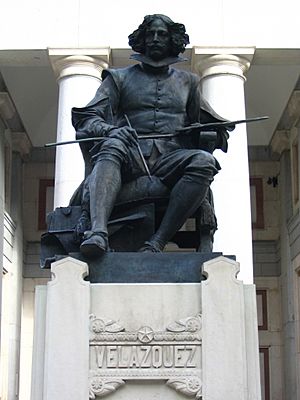
Between 1873 and 1900, the Prado helped decorate city halls, new universities, and churches. During the Second Spanish Republic (1931-1936), the museum focused on helping smaller museums in different regions. During the Spanish Civil War, the museum staff moved many artworks to safety. This was done on the advice of the League of Nations. They moved 353 paintings, 168 drawings, and the Dauphin's Treasure. The art traveled to Valencia, then Girona, and finally to Geneva. When World War II began, the art had to be returned to the museum by night trains through France.
The main building was expanded with small additions at the back between 1900 and 1960. Later, two other buildings nearby became part of the museum. These were the Casón del Buen Retiro and the Salón de Reinos. The Casón del Buen Retiro used to show 20th-century art. The Salón de Reinos was once an army museum.
In 2007, the museum finished a big expansion project designed by Rafael Moneo. This project increased the exhibition space to 16,000 square meters. The goal was to increase yearly visitors from 1.8 million to 2.5 million.
A new glass-roofed entrance area now holds the museum's shops and cafeteria. This frees up more space for art galleries in the main building. A 16th-century cloister (a covered walkway) was carefully taken apart stone by stone. It was then rebuilt in the new museum extension.
In 2016, it was announced that British architect Norman Foster would work with Carlos Rubio Carvajal. They will renovate the Hall of Realms, turning it into a new extension for the Prado. This project will add about 61,500 square feet of space, with 27,000 square feet for exhibitions. The Spanish government approved the plans in 2021.
The Prado Building's Design
The Prado Museum building is one of several grand buildings in Madrid. King Charles III wanted to create a beautiful city space. José Moñino y Redondo first thought of the idea. King Charles III then asked Juan de Villanueva to design the building in 1785. Villanueva also designed the nearby Botanical Garden and the City Hall of Madrid.
The area where the museum stands was once a "prado" (meadow). This meadow gave its name to the area, the Salón del Prado (now Paseo del Prado), and later to the museum itself. Building work stopped when Charles III's reign ended and during the Peninsular War. It only started again when King Ferdinand VII took over. During the war, the building was used by Napoleon's troops as a cavalry headquarters and gunpowder storage.
The next major renovations for the museum will be led by British architect Norman Foster. These renovations were approved in June 2020 and are expected to take at least four years.
Amazing Artworks at the Prado
The Prado Museum is famous for its incredible collection of art. Many of these pieces came from the Spanish royal collection.
Selected Famous Works
-
Rogier van der Weyden, The Descent from the Cross, around 1435
-
Andrea Mantegna, Death of the Virgin, around 1461
-
Albrecht Dürer Self-portrait, 1498
-
Fernando Yáñez de la Almedina, Saint Catherine of Alexandria, around 1510
-
Raphael, Portrait of a Cardinal, around 1510–11
-
Joachim Patinir, Landscape with Charon Crossing the Styx, around 1515–1524
-
Tintoretto, Christ Washing the Disciples' Feet, around 1518
-
Correggio, Noli me tangere, around 1525
-
Titian, Equestrian Portrait of Charles V, around 1548
-
Titian, La Gloria (Titian), around 1554
-
El Greco, Holy Trinity (El Greco), 1577–1579
-
El Greco, The Knight with His Hand on His Breast, around 1580
-
Georges de La Tour, Blind Man Playing the Hurdy-Gurdy, 1610–1630
-
Joos de Momper, Landscape with Sea and Mountains, around 1623
-
Anthony van Dyck, Self-portrait with Endymion Porter, around 1635
-
Diego Velázquez, The Surrender of Breda, 1634–35
-
Diego Velázquez, Mars Resting, 1639–1641
-
José de Ribera, Jacob's Dream, 1639
-
Claude Lorrain The Embarkation of Saint Paula, 1639–40
-
Francisco de Zurbarán, Agnus Dei, 1635–1640
-
Francisco de Zurbarán, Still Life with Pots, around 1650
-
Giovanni Battista Tiepolo, The Immaculate Conception, 1767
-
Francisco Goya, The Dog, 1819–1823
How the Prado Museum is Managed
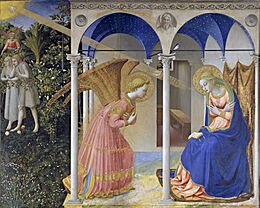
Funding the Museum
In 1991, Manuel Villaescusa left almost $40 million to the Prado Museum. This money was meant only for buying new paintings. The museum sold his properties to get the money. This gift suddenly made the Prado one of the strongest bidders for artworks in the world.
Until the early 2000s, the Prado's yearly income was about $18 million. Most of this came from the government. The rest came from private donations, books, and ticket sales. In 2001, the government decided to change how the museum was funded. They created a partnership between public and private groups.
Under new rules approved in 2003, the Prado had to get less money from the government over time. In return, the museum gained control of its own budget. It also got the power to raise money from companies and by selling merchandise. However, a large expansion project in 2004, costing €150 million, was paid for by the Spanish government.
Museum Directors
The first four directors of the Prado Museum were from noble families. From 1838 to 1960, most directors were artists. Since then, most have been art historians.
- The Marquess of Santa Cruz, 1817–1820
- The Prince of Anglona, 1820–1823
- José Idiáquez Carvajal, 1823–1826
- The Duke of Híjar, 1826–1838
- José de Madrazo, 1838–1857
- Juan Antonio de Ribera, 1857–1860
- Federico de Madrazo, 1860–1868
- Antonio Gisbert, 1868–1873
- Francisco Sans Cabot, 1873–1881
- Federico de Madrazo, 1881–1894
- Vicente Palmaroli, 1894–1896
- Francisco Pradilla, 1896–1898
- Luis Álvarez Catalá, 1898–1901
- José Villegas Cordero, 1901–1918
- Aureliano de Beruete y Moret, 1918–1922
- Fernando Álvarez de Sotomayor, 1922–1931
- Ramón Pérez de Ayala, 1931–1936
- Pablo Ruiz Picasso, 1936–1939
- Fernando Álvarez de Sotomayor, 1939–1960
- Francisco Javier Sánchez Cantón, 1960–1968
- Diego Angulo Íñiguez, 1968–1971
- Xavier de Salas Bosch, 1971–1978
- José Manuel Pita Andrade, 1978–1981
- Federico Sopeña, 1981–1983
- Alfonso Pérez Sánchez, 1983–1991
- Felipe Garín Llombart, 1991–1993
- Francisco Calvo Serraller, 1993–1994
- José María Luzón Nogué, 1994–1996
- Fernando Checa Cremades, 1996–2002
- Miguel Zugaza Miranda, 2002–2017
- Miguel Falomir, 2017 – present
Prado on Google Earth
In 2009, the Prado Museum chose 14 of its most important paintings to be shown on Google Earth and Google Maps. These images were extremely high quality. The largest one was 14,000 megapixels. This super zoom lets you see the paint texture and tiny details up close.
Other Museums Nearby
Just a few meters away from the Prado are two other important museums: the Thyssen-Bornemisza Museum and the Museo Reina Sofía.
Also nearby is the Real Academia de Bellas Artes de San Fernando. The National Archaeological Museum holds ancient collections. These include items from Spain, Ancient Egypt, Mesopotamia, Greece, and Rome.
The Naval Museum, run by the Ministry of Defence, is also close by.
Special Exhibitions at the Prado
From November 2011 to March 2012, 179 artworks from the Hermitage Museum in St. Petersburg were shown at the Prado. Some famous works included:
- A Scholar (1631), by Rembrandt
- The Lute Player (around 1596), by Caravaggio
- Ecstasy of Saint Teresa (1647), by Bernini
- Game of Bowls (1908), by Henri Matisse
- Bouquet of Cornflowers with Stems of Oats in a Vase (around 1900), by House of Fabergé
- Pond at Montgeron (1876), by Claude Monet
- Belt buckle with a monster attacking a horse, (4th–3rd century BC), a gold ornament from Peter I's Siberian Collection
- Moonrise, Two Men on the Shore (around 1900), by Caspar David Friedrich
- Composition VI (1913), by Wassily Kandinsky
- Metaphysical Still life (1918), by Giorgio Morandi
Also, for the first time in its 200-year history, the Prado Museum sent an exhibition of its Italian masterpieces to Australia. This show was at the National Gallery of Victoria in Melbourne from May to August 2014. Many of these artworks had never left Spain before.
Images for kids
See also
 In Spanish: Museo del Prado para niños
In Spanish: Museo del Prado para niños
- List of largest art museums


